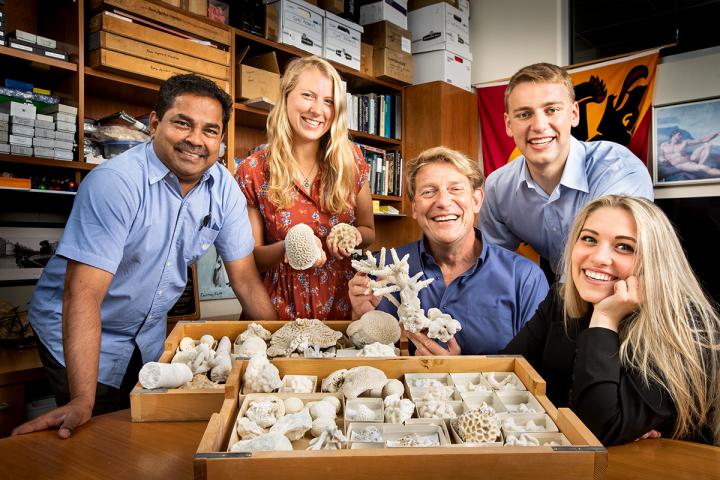
Credit: Fred Zwicky
CHAMPAIGN, Ill. — Newly developed geological techniques help uncover the most accurate and high-resolution climate records to date, according to a new study. The research finds that the standard practice of using modern and fossil coral to measure sea-surface temperatures may not be as straightforward as originally thought. By combining high-resolution microscopic techniques and geochemical modeling, researchers are using the formational history of Porites coral skeletons to fine-tune the records used to make global climate predictions.
The new findings are reported in the journal Frontiers in Marine Science.
For over 500 million years, corals have been passively keeping track of changing sea-surface temperature by recording the ratio of calcium to strontium and oxygen isotopes within their skeletons, the researchers said. The coral skeletons – which are made of calcium carbonate mineral – grow layers like tree rings that have increased amounts of strontium and the lighter isotope of oxygen during the warmer season. Climate scientists take advantage of this process to track sea surface temperature through time.
However, this climate-tracking technique is not without its flaws, said University of Illinois geology and microbiology professor Bruce Fouke, who led the new research.
“We can ground truth coral-based sea-surface temperature records against records made using temperature probes,” Fouke said, “Remarkably, the coral records are accurate most of the time, but there are instances where measurements have been off by as much as nine degrees Celsius, and this needs to be rectified.”
To grow their skeletons, coral polyps deposit aragonite. However, the mineral also crystalizes from seawater, the researchers said, and that can cause problems when analyzing the original coral skeleton chemistry. As seawater flows through the porous coral structure, it deposits newly crystalized aragonite on top of skeletons. That new aragonite, which may record a different sea-surface temperature, alters original skeletal chemistry through a process called diagenesis, Fouke said.
“It is difficult to tell the diagenetic aragonite from the original coral skeleton without using high-powered microscopes,” said Kyle Fouke, a Bucknell University undergraduate student, Carl R. Woese Institute for Genomic Biology affiliate and co-author of the study. “It is also challenging to know exactly when the diagenetic alteration took place – days or decades after the skeletons were formed. Unless you are using the newest microscopy techniques to help select your samples, you could be collecting and measuring a mix of the two very different temperature records.”
To test this, the team collected drill cores from the skeletons of living Porites coral heads at 10 to 100 feet water depth on the Great Barrier Reef off the coast of Australia. These large coral heads reach nearly 10 feet in diameter, and some have been growing for hundreds of years.
“Based on our analyses, we see that the older portions of the coral heads growing in deeper seawater contain a higher concentration of diagenetic aragonite,” Kyle Fouke said.
“Using a broad array of light, electron and X-ray microscopy techniques – made available under the direction of study co-author Mayandi Sivaguru, an associate director at the Carl R. Woese Institute for Genomic Biology Microscopy Core at the U. of I. – we were able to clearly differentiate between the original skeleton and diagenetic aragonite, when present,” said Lauren Todorov, a molecular and cellular biology undergraduate student and study co-author.
Using these techniques, the team uncovered a multitude of different aragonite crystallization histories, ranging from seasonal variations in skeletal growth to smaller-scale processes that could be occurring on daily – even hourly – cycles.
By taking the extra steps to sort out the relative timing between the skeletal and diagenetic aragonite crystallization, the team integrated its data with chemical-mixing models for calcium, strontium and oxygen isotopes from geochemical studies of Porites from Papua New Guinea. From this, the team created the first reliable and reproducible correction factor that determines the magnitude of error that diagenetic alteration can place on sea-surface temperature measurements.
“Additionally, because this has been achieved using the carbonate mineral aragonite, which is ubiquitous among marine life, this same correction factor can be used with other sea creatures that secrete carbonate skeletons and shells,” Bruce Fouke said.
Sea-surface temperature records derived from coral skeleton chemistry are the gold standard for accurate climate reconstructions and future predictions, the researchers said, and this new insight only further strengthens this tool.
###
The NASA Astrobiology Institute, Office of Naval Research and the Australian Research Council supported this study.
Editor’s notes:
To reach Bruce Fouke, call 217-244-5431; email [email protected].
The paper “Correction factors for 18O-derived global sea surface temperature reconstructions from diagenetically altered intervals of coral skeletal density banding” is available online and from the U. of I. News Bureau. DOI: 3389/fmars.2019.00306
Media Contact
Lois Yoksoulian
[email protected]
Original Source
https:/
Related Journal Article
http://dx.




